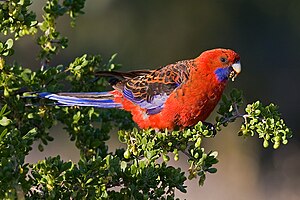Flat-tailed Parakeets
| Flat-tailed Parakeets ie p. | ||||||||||||
|---|---|---|---|---|---|---|---|---|---|---|---|---|

Pennant Parakeet ( Platycercus elegans ) |
||||||||||||
| Systematics | ||||||||||||
|
||||||||||||
| Scientific name | ||||||||||||
| Platycercus | ||||||||||||
| Vigors , 1825 |
The flat-tailed parakeets ie S. ( Platycercus ) are a genus of birds from the family of real parrots (Psittacidae).
Six species belong to the genus . Adelaide and straw parakeet, which are often listed as separate species, are, as mtDNA studies have shown, subspecies of the Pennant Parakeet ( Platycercus elegans ).
Appearance
The brightly colored species of this genus are, along with the cockatoos, the characteristic birds of the Australian avifauna . What is noticeable about the parrots is the wide fringing of feathers on the back and the distinctive color of the cheeks. Three superspecies can be distinguished. It is the geographically exclusive blauwangigen and weißwangigen species ( Green Rosella and Pennant parakeet , respectively, Rosella , pale-headed rosella and Northern Rosella ), as well as the isolated occurring gelbwangige kind of Western Rosella . A main feature is their stepped tail, as long or longer than the wings; the four central control springs are almost the same length and only slightly narrowed at the end. Males and females differ in color. Juveniles can be distinguished from adults . Platycercus species are medium-sized parrots, with the yellow-bellied parakeet reaching a size of 37 cm. The smallest species of this genus is the Stanley's Parakeet with 26 cm. The length of the tail accounts for almost half the size. Another characteristic of the group is the rapid, undulating flight with flat wing beats and short gliding phases; less pronounced in the yellow-bellied parakeet.
The complete genetic isolation of the species has not yet been achieved, as hybrid formations occur in the contacting areas of distribution . Hybrid breeding in captivity shows that all hybrids are fertile .
distribution
The genus colonizes the Australian continent in the extreme southwest, in the northern coastal areas and in the east , as well as in Tasmania and some coastal islands. The south-east of the continent has the greatest density of species.
In addition, there are naturalized occurrences of the Rosella Parakeet ( P. eximius ) and the Pennant Parakeet ( P. elegans ) in New Zealand , the latter also on the Norfolk Island .
habitat
All species occur in open savanna-like forest and scrubland and in gallery forests . The brown parakeet ( P. venustus ) also inhabits mangroves along the north coast of Australia . The yellow-bellied parakeet and the Pennant parakeet ( nominate form ) also inhabit relatively closed, moist coastal and mountain forests.
Cultivated land, especially orchards, and populated areas with gardens and parks offer the parakeets very similar living conditions as the open woodland. Such habitats are adopted to varying degrees by all species.
Species and subspecies of the genus
- Genus Platycercus
- Yellow-bellied Parakeet , Platycercus caledonicus
-
Pennant Parakeet , Platycercus elegans
- Pennant Parakeet, P. e. elegans
- Dark Pennant Parakeet, P. e. nigresceus
- Kangaroo Island Pennant Parakeet, P. e. melanopterus
- Light Pennant Parakeet, P. e. fleurieuensis
- Northern straw parakeet, P. e. subadelaidae
- Southern straw parakeet, P. e. flaveolus
- Adelaide Parakeet, wild mongrel from: P. e. fleurieuensis x P. e. subadelaidae x P. e. flaveolus
-
Rosella Parakeet , Platycercus eximius
- Southern Rosella, P. e. eximius
- Northern Rosella, P. e. elecica
- Tasmanian Rosella, P. e. diemenensis
-
Pale head rosella , Platycercus adscitus
- Northern pale head rosella, P. a. adscitus
- Southern pale head rosella, P. a. palliceps
-
Brown Parakeet , Platycercus venustus
- Dark Brown Parakeet, P. v. venustus
- Light Brown Parakeet, P. v. hilli
-
Stanley's Parakeet , Platycercus icterotis
- Green-backed parakeet, P. i. icterotis
- Blue-backed Anley Parakeet, P. i. xanthogenys
literature
- Nigel J. Collar: Psittacidae (Parrots). In: Josep del Hoyo : Handbook of the Birds of the World. Volume 4: Sandgrouse to Cuckoos. Lynx Edicions , Barcelona 1997, ISBN 84-87334-22-9 , pp. 280ff.
- EC Dickinson (Eds.): The Howard and Moore Complete Checklist of the Birds of the World. Princeton University Press , Princeton / Oxford 2003.
- Joseph M. Forshaw: Parrots of the World . Weldon & Associates Pty, Australia 1989.
- Joseph M. Forshaw: Australian Parrots . Vol. 2, Arndt Verlag , Bretten 2002, ISBN 3-9808245-2-7 .
- Joseph M. Forshaw: Parrots of the World. An Identification Guide. Princeton University Press, Princeton 2006.
- Dieter Hoppe : Biology and care of the flat-tailed parakeets . (= The aviary. Special issue 6). Schaper Verlag, Hanover 1986.
- Klaus Immelmann, Dieter Vogels: The Australian flat-tailed parakeets. Ziemsen Verlag , Wittenberg 1989, ISBN 3-7403-0228-3 .
- Tony Juniper, Mike Parr: Parrots. Pica Press, Sussex 1998, ISBN 0-300-07453-0 .
- JR Ovenden, AG Mackinley, RH Crozier: Systematics and Mitochondrial Genome Evolution of Australian Rosellas (Aves: Platycercidae). In: Mol. Biol. Evo. 4 (5), 1987, pp. 526-542.
- Franz Robiller: Parrots. Vol. 2, Ulmer Verlag , Stuttgart 1997, ISBN 3-8001-7229-1 .
- HE Wolters: Die Vogelarten der Erde - a systematic list with distribution information as well as German and English names. 1. Lief., Sheets 1–5. Parey, Hamburg / Berlin 1975.

